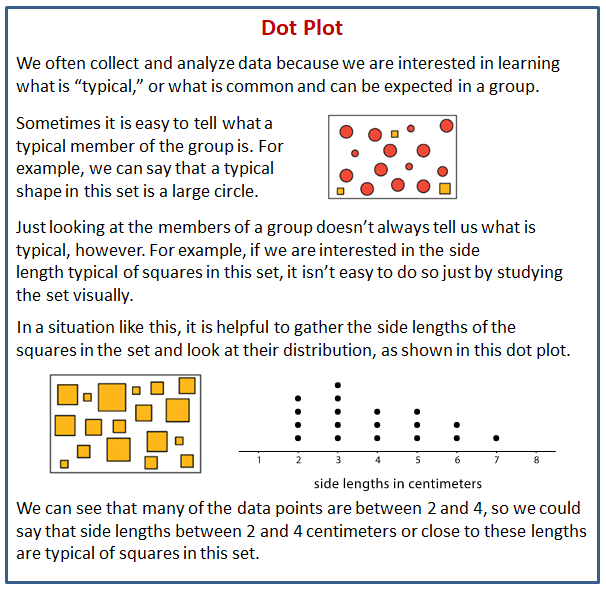Illustrative Mathematics Unit 6.8, Lesson 4: Dot Plots
Learning Targets:
- I can describe the center and spread of data from a dot plot.
Related Pages
Illustrative Math
Grade 6
Lesson 4: Dot Plots
Let’s investigate what dot plots and bar graphs can tell us.
Illustrative Math Unit 6.8, Lesson 4 (printable worksheets)
Lesson 4 Summary
The following diagram shows what information can be obtained from a dot plot.

Lesson 4.1 Pizza Toppings (Part 1)
Fifteen customers in a pizza shop were asked, “How many toppings did you add to your cheese pizza?” Their responses are shown in the table.
- Could you use a dot plot to represent the data? Explain your reasoning.
- Complete the table.
Scroll down the page for the solutions to the “Are you ready for more?” section.
Lesson 4.2 Pizza Toppings (Part 2)
- Use the tables from the warm-up to display the number of toppings as a dot plot. Label your drawing clearly.
- Use your dot plot to study the distribution for number of toppings. What do you notice about the number of toppings that this group of customers ordered? Write 2–3 sentences summarizing your observations.
Are you ready for more?
Think of a statistical question that can be answered with the data about the number of toppings ordered, as displayed on the dot plot. Then answer this question.
-
Show Answer
Example: What is the most common number of toppings customers add to their cheese pizza?
Lesson 4.3 Homework Time
Twenty-five sixth-grade students answered the question: “How many hours do you generally spend on homework each week?”
- Why is this question a statistical question?
- This dot plot shows the number of hours per week that these 25 students reported spending on homework.
Use the dot plot to answer the following questions. For each, show or explain your reasoning.
a. What percentage of the students reported spending 1 hour on homework each week?
b. What percentage of the students reported spending 4 or fewer hours on homework each week? - Would 6 hours per week be a good description of the number of hours this group of students spends on homework per week? What about 1 hour per week? Explain your reasoning.
- What value do you think would be a good description of the homework time of the students in this group? Explain your reasoning.
- Someone said, “In general, these students spend roughly the same number of hours doing homework.” Do you agree? Explain your reasoning.
Lesson 4 Practice Problems
- Clare recorded the amounts of time spent doing homework, in hours per week, by students in sixth, eighth, and tenth grades. She made a dot plot of the data for each grade and provided the following summary.
- Students in sixth grade tend to spend less time on homework than students in eighth and tenth grades.
- The homework times for the tenth-grade students are more alike than the homework times for the eighth-grade students.
Use Clare’s summary to match each dot plot to the correct grade (sixth, eighth, or tenth).
- Mai played 10 basketball games. She recorded the number of points she scored and made a dot plot. Mai said that she scored between 8 and 14 points in most of the 10 games, but one game was exceptional. During that game she scored more than double her typical score of 9 points. Use the number line to make a dot plot that fits the description Mai gave.
- A movie theater is showing three different movies. The dot plots represent the ages of the people who were at the Saturday afternoon showing of each of these movies.
a. One of these movies was an animated movie rated G for general audiences. Do you think it was Movie A, B, or C? Explain your reasoning.
b. Which movie has a dot plot with ages that that center at about 30 years?
c. What is a typical age for the people who were at Movie A? - Find the value of each expression.
a. 3.727 + 1.384
b. 3.727 - 1.384
c. 5.01 · 4.8
d. 5.01 ÷ 4.8
The Open Up Resources math curriculum is free to download from the Open Up Resources website and is also available from Illustrative Mathematics.
Try out our new and fun Fraction Concoction Game.
Add and subtract fractions to make exciting fraction concoctions following a recipe. There are four levels of difficulty: Easy, medium, hard and insane. Practice the basics of fraction addition and subtraction or challenge yourself with the insane level.

We welcome your feedback, comments and questions about this site or page. Please submit your feedback or enquiries via our Feedback page.